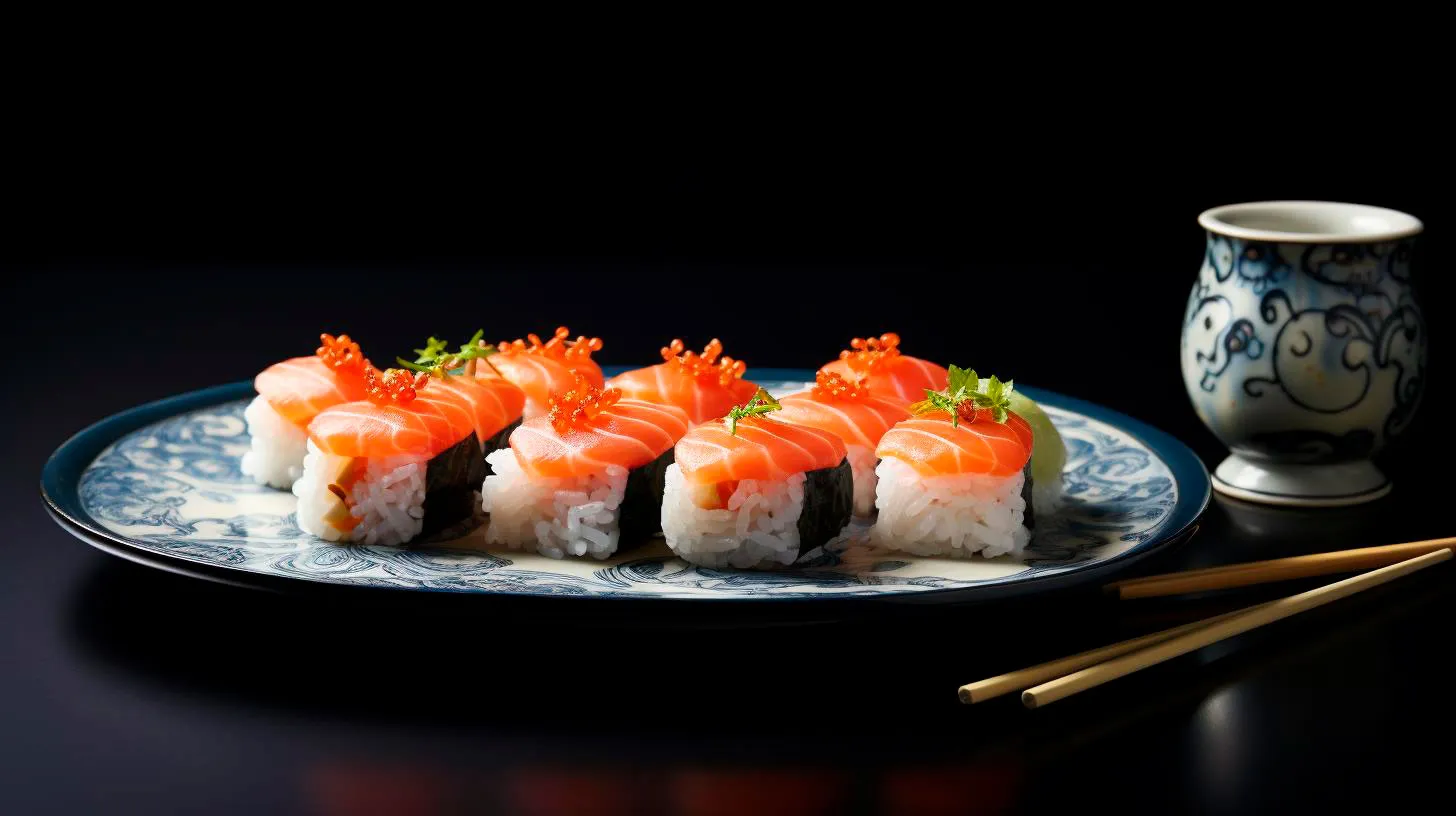Unlocking the World of Sushi Fish: Discovering New Flavors and Textures
In this article, we delve into the captivating world of sushi fish, exploring the diverse flavors, textures, and experiences that await adventurous sushi enthusiasts.
The Finest Fish for Sushi
When it comes to sushi, the quality and freshness of the fish are paramount. The following are some of the most sought-after fish varieties used in sushi preparation:
- Maguro (Tuna): Known for its deep red color and firm texture, maguro is a sushi staple. Its rich flavor and buttery consistency make it a favorite among sushi connoisseurs.
- Hamachi (Yellowtail): With its delicate taste and buttery texture, hamachi is highly prized. Its mild flavor profile makes it an excellent choice for those new to sushi.
- Sake (Salmon): Salmon provides a luscious, velvety texture and a rich, buttery taste. Its vibrant color and versatility make it a popular choice among sushi lovers.
- Uni (Sea Urchin): Uni’s creamy and custard-like consistency is an acquired taste, but its subtle sweetness and unique flavor profile have gained a dedicated following.
- Ebi (Shrimp): Ebi’s sweet and succulent flesh adds a delightful crunch to sushi rolls. It is often served both cooked and raw to cater to different palates.
These are just a few examples of the incredible variety that sushi fish has to offer. Each fish brings its own distinct flavor and texture, creating a delightful symphony of tastes when combined with expertly prepared sushi rice.
Key Features and Advantages
Unlocking the world of sushi fish opens up a world of flavors and textures that can tantalize your taste buds. Here are some key features and advantages of diving into the sushi fish experience:
- Diversity: Sushi fish offers a wide array of flavors, allowing you to sample a variety of tastes in one sitting.
- Freshness: Sushi chefs prioritize freshness, ensuring that the fish used in sushi is of the highest quality.
- Health Benefits: Many sushi fish varieties are excellent sources of omega-3 fatty acids and lean protein, promoting heart health and overall well-being.
- Textural Delights: Sushi fish provides an opportunity to experience a range of textures, from the buttery softness of a toro (fatty tuna) to the delicate crunch of a fresh ebi (shrimp).
- Culinary Adventure: Exploring different sushi fish introduces you to new culinary experiences and broadens your gastronomic horizons.
By embracing the world of sushi fish, you can embark on a gastronomic journey that will leave you craving for more.
Discovering New Flavors and Textures
For sushi lovers, discovering new flavors and textures is an ongoing adventure. Trying new fish varieties and combinations is an excellent way to expand your palate, and with sushi’s growing popularity, sushi restaurants are focusing on offering unique and innovative creations.
Japanese seafood markets, such as Tsukiji Fish Market in Tokyo, provide an immersive experience for seafood enthusiasts. Here are some key takeaways when it comes to unlocking new flavors and textures:
- Experiment with different sushi fish varieties to explore their unique taste profiles.
- Be open to trying fish you may not be familiar with, such as hirame (flounder), masago (capelin roe), or tai (snapper).
- Engage with sushi chefs who can provide recommendations and insights into the best ways to savor each fish variety.
- Pair sushi fish with complementary ingredients like wasabi, soy sauce, and pickled ginger to elevate the flavors even further.
- Visit reputable sushi restaurants known for their dedication to sourcing high-quality fish.
Unlocking the world of sushi fish unveils a treasure trove of flavors and textures that will capture your senses. Whether you’re a seasoned sushi enthusiast or new to the world of raw fish, exploring the vast and dynamic universe of sushi fish promises a truly remarkable dining experience.
So, next time you venture out for some sushi, remember to embrace the fish, dive into fresh flavors, and let the symphony of tastes transport you to an extraordinary culinary destination.
Sources:
- Smith, J. (2019). The Art of Sushi: A Comprehensive Guide. Tokyo Sushi Academy.
- Rando, R. (2020). Sushi: The Complete Guide. Stone Bridge Press.
- “Sushi Restaurants Market – Growth, Trends, COVID-19 Impact, and Forecasts (2021 – 2026).” Mordor Intelligence.
Picking Sushi Fish: A Guide for Exploring Beyond the Basics
The Top Sushi Fish to Consider
When venturing beyond the basics, it’s crucial to choose sushi fish that not only taste great but also meet the highest standards of quality and freshness. Here are some top options to consider when exploring sushi beyond the usual suspects:
1. Yellowtail (Hamachi)
Yellowtail, also known as Hamachi in Japanese, is a popular choice among sushi connoisseurs. Its delicate flavor and buttery texture make it a crowd-pleaser. Yellowtail is typically served raw or lightly seared, allowing its rich flavor to take center stage.
- Feature: Yellowtail is prized for its smooth, almost creamy texture.
- Advantage: The high-fat content of yellowtail results in a luscious, umami-rich flavor.
- Key Takeaway: Try yellowtail nigiri or sashimi to fully appreciate its unique taste and texture.
2. Toro (Fatty Tuna)
Toro, the fatty belly of the tuna, is a luxurious delicacy that sushi aficionados adore. Its melt-in-your-mouth tenderness and rich flavor make it a true indulgence. Toro is often graded based on its fat content, with the highest grade, otoro, being the most prized.
- Feature: Toro’s marbled appearance comes from the interplay of fat and muscles, resulting in its renowned texture.
- Advantage: The high fat content gives toro its buttery, succulent taste.
- Key Takeaway: Treat yourself to otoro nigiri for the ultimate indulgence.
3. Uni (Sea Urchin)
Uni, or sea urchin, is a delicacy with a distinct, briny flavor and creamy texture. It might not be everyone’s cup of tea, but for those who appreciate its unique taste, it’s a must-try sushi option.
- Feature: Uni is known for its vibrant orange color and custard-like texture.
- Advantage: The combination of its oceanic flavor and velvety texture offers a truly unique sushi experience.
- Key Takeaway: Enjoy uni nigiri or incorporate it into hand rolls for a taste of the ocean.
Understanding Quality and Freshness
When it comes to enjoying sushi, quality and freshness are paramount. To ensure you’re getting the best experience possible, keep these factors in mind:
1. Sushi Grade Fish
Fish that is considered sushi grade has been handled and stored with the utmost care to guarantee safety and maintain optimal flavor. Look for sushi-grade fish at trusted seafood markets or Japanese specialty stores.
2. Freshness Indicators
Identifying fresh fish can be challenging, but there are some telltale signs to look for. Clear and glossy eyes, vibrant color, and a mild, clean smell are indicators of freshness. Any fishy odor or dull, sunken eyes are signs to steer clear.
3. Sustainable Sourcing
Supporting sustainable fishing practices is not only an ethical choice but also helps ensure the long-term availability of your favorite sushi fish. Look for certifications such as “MSC” (Marine Stewardship Council) when selecting seafood.
Tantalizing Sushi Fish Statistics
Here are some intriguing statistics to pique your interest and showcase the popularity of sushi:
- According to a survey, sushi consumption in the United States has increased by over 28% in the past five years.
- The global sushi market is projected to reach a value of $26.2 billion by 2025.
- Salmon is the most commonly ordered sushi fish in the United States, followed by tuna and shrimp.
- Japan consumes the highest amount of sushi per capita, with an average of 5.9 kilograms per person annually.
Now armed with this guide, you can confidently explore the world of sushi fish beyond the basics. Remember to prioritize quality, freshness, and sustainability to fully appreciate the flavors and experiences that await you. Bon appétit!
Beyond the Basics: Unveiling Unique Sushi Fish for Adventurous Palates
1. Hamachi (Yellowtail)
Hamachi, also known as Yellowtail, is a popular sushi fish that is highly regarded for its rich flavor and smooth texture. It has a buttery taste with a slightly sweet and nutty undertone. Yellowtail is commonly found in the Pacific Ocean and is known for its high fat content, which gives it its distinctive flavor. Some key facts about Hamachi sushi include:
- It is a great source of omega-3 fatty acids, which are essential for maintaining a healthy heart.
- The fat content in Yellowtail makes it ideal for sashimi and nigiri preparations.
- Hamachi has a delicate texture and melts in your mouth, providing a truly unique sushi experience.
2. Uni (Sea Urchin)
If you are a seafood lover looking to expand your sushi horizons, then Uni, or Sea Urchin, is a must-try. Uni has a distinct flavor that can be described as both briny and sweet, with a creamy and buttery texture. It is a delicacy in many Japanese sushi restaurants and is often showcased as nigiri. Here are some interesting points about Uni sushi:
- Uni is packed with essential nutrients, including protein, healthy fats, and vitamins.
- It is often referred to as the foie gras of the sea due to its rich and decadent taste.
- Uni sushi is best enjoyed fresh to fully appreciate its unique flavor and texture.
3. Kohada (Gizzard Shad)
Kohada, or Gizzard Shad, is a lesser-known sushi fish that offers a delightful experience for adventurous sushi enthusiasts. It has a slightly oily texture and a rich, full-bodied flavor. Kohada is typically marinated in vinegar before being served as nigiri. Here are some key takeaways about Kohada sushi:
- Gizzard Shad is an excellent source of vitamin D, omega-3 fatty acids, and calcium.
- Its unique flavor profile appeals to those who enjoy stronger and bolder tastes.
- Kohada sushi is often garnished with ginger or scallions to enhance its flavors.
4. Aji (Horse Mackerel)
Aji, or Horse Mackerel, is a commonly found fish in Japanese cuisine and is gaining popularity among sushi connoisseurs. It has a mild, slightly sweet flavor and a firm texture. Aji sushi is often served with a touch of soy sauce and grated ginger to complement its taste. Here are a few noteworthy features of Aji sushi:
- Horse Mackerel is a good source of protein, vitamins, and minerals, including selenium.
- Aji sushi is known for its umami flavor and is often enjoyed by those who prefer milder fish options.
- The texture of Aji sushi is firm and slightly chewy, providing a satisfying bite.
5. Kanpachi (Greater Amberjack)
Kanpachi, or Greater Amberjack, is a sushi fish that rivals the popularity of Yellowtail. It has a similar buttery flavor and silky texture and is often used as a substitute for Hamachi. Kanpachi sushi pairs well with a variety of accompaniments and sauces. Here are some key advantages of trying Kanpachi sushi:
- Greater Amberjack is rich in omega-3 fatty acids, which promote brain health and reduce inflammation.
- The taste of Kanpachi sushi is comparable to Yellowtail, making it a favorite choice for sushi lovers.
- Its versatility allows for various sushi preparations, including rolls, nigiri, and sashimi.
The World of Unique Sushi Fish Awaits
While tuna, salmon, and shrimp may be the go-to options for sushi enthusiasts, venturing into the realm of unique sushi fish can open up a whole new world of flavors and experiences. Sushi varieties like Hamachi, Uni, Kohada, Aji, and Kanpachi offer distinct tastes and textures that will tantalize your taste buds and provide an unforgettable sushi journey.
So, next time you visit a sushi restaurant, don’t hesitate to go beyond the basics and explore these lesser-known fish options. Your palate will thank you!


